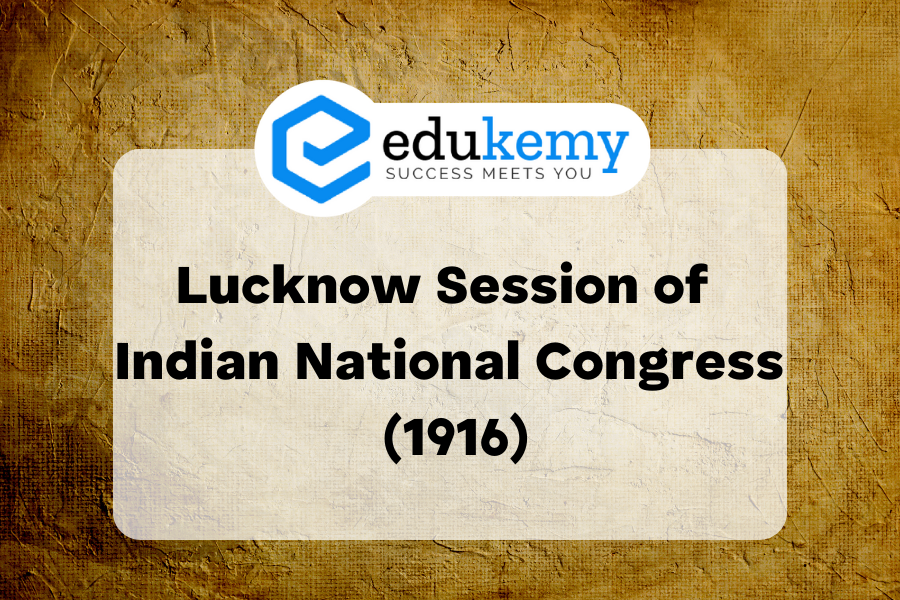
The Lucknow Session of the Indian National Congress was chaired by Ambica Charan Mazumdar and marked the 31st gathering of the INC in Lucknow. This session holds historic significance due to crucial decisions made, particularly the reconciliation between the moderates and the extremists. After a decade of ideological disputes since their split in the Surat session of 1907, this event signified a pivotal moment.
Bal Gangadhar Tilak, in a key role, assured the moderates that the extremists would abstain from adopting any agitational strategy or politics in their protest against the British. This assurance played a crucial role in facilitating the reconciliation. The demise of prominent Moderate leaders like Gopal Krishna Gokhale and Pherozeshah Mehta further reduced opposition to the amalgamation of the Congress factions (Extremists and Moderates).
This situation paved the way for Tilak and Annie Besant to emerge as dominant figures within the Congress. The historic Lucknow Pact between Congress and the Muslim League was also signed during this session. For those preparing for the UPSC exam, understanding the nuances of the Lucknow Session of INC becomes crucial.
Contents
Lucknow Session – Background
- World War 1: British vs Ottoman Empire (Turkey) hurts Muslim sentiments, annoys Muslim League.
- British annulment of Partition of Bengal (1905) angers Muslim League, originally supportive.
- British rejection of Aligarh university adds to Muslim frustration.
- Congress seeks mass support for anti-British struggle.
- Muhammad Ali Jinnah: Member of Congress and Muslim League, advocates for Indian autonomy and protects Muslim interests.
- Jinnah was awarded the title “the Ambassador of Hindu-Muslim Unity” by Sarojini Naidu for reconciliation efforts.
- Session marks reconsolidation of Hindus and Muslims, Moderates and Extremists.
- Collective demand for “home rule for India” emerges.
- Strengthens the Nationalist movement in India.
Readmission of Extremists to Congress
- Reunion Factors:
- Irrelevance of Old Controversies: Previous disputes were no longer pertinent.
- Recognition of Political Inaction: Moderates and Extremists acknowledged that the split had led to political stagnation.
- Efforts by Annie Besant and Tilak: Annie Besant and Tilak played key roles in working towards reconciliation.
- Tilak’s Assurances to Moderates: Tilak, to allay Moderate concerns, supported administrative reform over government overthrow. He condemned violent actions.
- Death of Pherozeshah Mehta: The demise of Mehta, leader of Moderate opposition to Extremists, facilitated the reunion.
Lucknow Pact
In Lucknow, another momentous occurrence was the alliance formed between the Muslim League and the Congress, jointly presenting a set of common demands to the government. This took place at a juncture when the Muslim League, now under the sway of younger militant nationalists, was aligning more closely with Congress’s objectives and adopting a stronger anti-imperialist stance.
The Lucknow Pact between the Congress and the Muslim League stands out as a watershed moment in the nationalistic struggle for freedom. Notably, the League committed to presenting the government with joint constitutional demands. In reciprocation, the Congress accepted the Muslim League’s stance on separate electorates, with the provision remaining until any community sought joint electorates.
Moreover, Muslims were allocated a fixed proportion of seats in both all-India and provincial legislatures, further solidifying the terms of the alliance.
Conclusion
The acceptance of separate communal electorates in the Lucknow Pact marked the inception of communal politics in India. This development is viewed as the precursor to the “two-nation theory,” ultimately culminating in the partition of India in 1947. Through this pact, the Congress officially recognized the Muslim League as the political representative of Muslims in India.
In response, the British government introduced the Montagu-Chelmsford declaration, leading to the arrest of Annie Besant. Simultaneously, a show-cause notice was imposed on Bal Gangadhar Tilak, contributing to the dismantling of the Home-rule Movement.
FAQs
Question 1: What was the major achievement of the Lucknow Session of 1916?
Answer: The major achievement of the Lucknow Session of 1916 was the historic Lucknow Pact between the Indian National Congress and the Muslim League. This pact marked a significant milestone in India’s nationalistic struggle as it brought Hindus and Muslims together, fostering unity and presenting a set of common demands to the British government.
Question 2: What factors aided in the readmission of Extremists to Congress?
Answer: The readmission of Extremists to Congress was facilitated by several factors, including the irrelevance of old controversies, the acknowledgment by both Moderates and Extremists that their split had resulted in political inaction, and concerted efforts by leaders like Annie Besant and Bal Gangadhar Tilak to bring the two factions back together.
Question 3: Who played a key role in the readmission of Extremists to Congress?
Answer: Notable figures like Annie Besant and Bal Gangadhar Tilak played crucial roles in the readmission of Extremists to Congress. Their efforts in bridging the gap and fostering reconciliation were instrumental in overcoming past differences and rebuilding unity within the Indian National Congress.
In case you still have your doubts, contact us on 9811333901.
For UPSC Prelims Resources, Click here
For Daily Updates and Study Material:
Join our Telegram Channel – Edukemy for IAS
- 1. Learn through Videos – here
- 2. Be Exam Ready by Practicing Daily MCQs – here
- 3. Daily Newsletter – Get all your Current Affairs Covered – here
- 4. Mains Answer Writing Practice – here

